
Assisi is a town and commune of Italy in the Province of Perugia in the Umbria region, on the western flank of Monte Subasio.
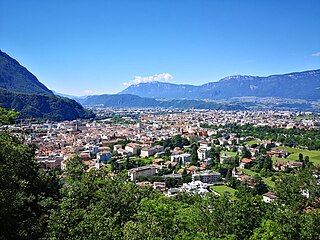
Bolzano is the capital city of South Tyrol, Northern Italy. With a population of 108,245, Bolzano is also by far the largest city in South Tyrol and the third largest in historical Tyrol. The greater metro area has about 250000 inhabitants and is one of the urban centres within the Alps.
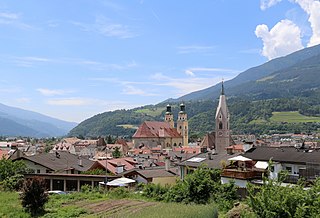
Brixen is a town and commune in South Tyrol, northern Italy, located about 40 kilometres (25 mi) north of Bolzano.

Sterzing is a comune in South Tyrol in northern Italy. It is the main town of the southern Wipptal, and the Eisack River flows through the medieval town. It is one of I Borghi più belli d'Italia.

The Basilica of Saint Francis of Assisi is the mother church of the Roman Catholic Order of Friars Minor Conventual in Assisi, a town in the Umbria region in central Italy, where Saint Francis was born and died. It is a papal minor basilica and one of the most important places of Christian pilgrimage in Italy. With its accompanying friary, Sacro Convento, the basilica is a distinctive landmark to those approaching Assisi. It has been a UNESCO World Heritage Site since 2000.
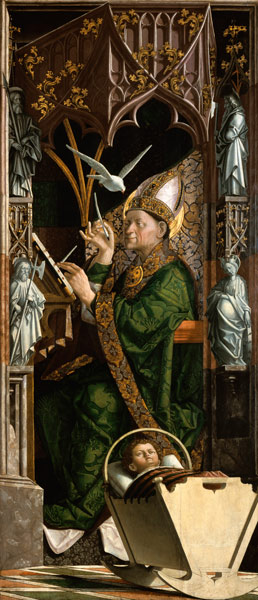
Michael Pacher was a painter and sculptor from Tyrol active during the second half of the fifteenth century. He was one of the earliest artists to introduce the principles of Renaissance painting into Germany. Pacher was a comprehensive artist with a broad range of sculpting, painting, and architecture skills producing works of complex wood and stone. He painted structures for altarpieces on a scale unparalleled in North European art.

The Prince-Bishopric of Brixen was an ecclesiastical principality of the Holy Roman Empire in the present-day northern Italian province of South Tyrol. It should not be confused with the larger Catholic diocese, over which the prince-bishops exercised only the ecclesiastical authority of an ordinary bishop. The bishopric in the Eisack/Isarco valley was established in the 6th century and gradually received more secular powers. It gained imperial immediacy in 1027 and remained an Imperial Estate until 1803, when it was secularised to Tyrol. The diocese, however, existed until 1964, and is now part of the Diocese of Bolzano-Brixen.

The Basilica of Saint Mary of the Angels is a papal minor basilica situated in the plain at the foot of the hill of Assisi, Italy, in the frazione of Santa Maria degli Angeli.
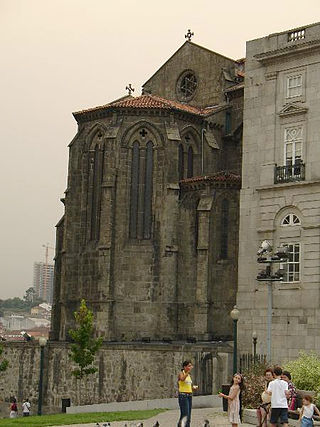
The Church of Saint Francis is the most prominent Gothic monument in Porto, Portugal, being also noted for its outstanding Baroque inner decoration. It is located in the historic centre of the city, declared World Heritage Site by UNESCO.

Brenner is a comune and a village in South Tyrol in northern Italy, located about 60 km (37 mi) north of Bolzano on the border with Tyrol, Austria.

Kurtatsch an der Weinstraße, often abbreviated to Kurtatsch or Cortaccia, is a comune (municipality) and a village in South Tyrol in northern Italy, located about 25 kilometres (16 mi) southwest of the city of Bolzano. Kurtatsch is one of the southernmost villages in the German-speaking area.

The Basilica of Saint Francis is a historic church in the city of Bologna in northern Italy. Founded in the 13th century, it has been the property of the Conventual Franciscan friars since then. The church has been raised to the rank of a minor basilica by the Holy See.

Bolzano/Bozen railway station is the main station of Bolzano, capital of the autonomous province of South Tyrol, in northeastern Italy.

Saint Francis Receiving the Stigmata is a panel painting in tempera by the Italian artist Giotto, painted around 1295–1300 for the Church of Saint Francis in Pisa and it is now in the Musée du Louvre in Paris. It shows an episode from the life of Saint Francis of Assisi, and is 314 cm high by 162 cm wide. It is signed OPUS IOCTI FLORENTINI.

The Chiesa dei Domenicani is a medieval church in Bolzano/Bozen, South Tyrol, northern Italy.

The Franciscan Church is one of the oldest churches in Salzburg, Austria. The church is located at the intersection of Franziskanergasse and Sigmund-Haffner-Gasse opposite the Franciscan Friary in the Altstadt section of the city. The first church on this site was erected in the eighth century. Between 1408 and 1450, a Gothic choir replaced the Romanesque choir. A slender Gothic tower was added between 1468 and 1498. The church was dedicated to the Virgin Mary and served as the parish church until 1635. It was ceded to the Franciscan Order in 1642. Johann Bernhard Fischer von Erlach redesigned the church interior in the baroque style in the eighteenth century.

Kaltern Friary is a Franciscan friary in Kaltern, South Tyrol, Italy. It is located in the centre of the little town and dates back to the 17th century.
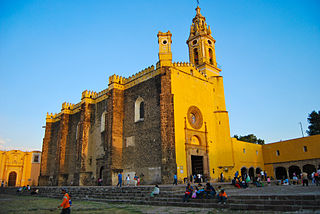
The San Gabriel Franciscan Convent or San Gabriel Friary is a church and friary in Cholula, Metropolitan area of Puebla City, Mexico.

The cathedral Maria Himmelfahrt is the parish church of the South Tyrolean capital Bolzano and cathedral of the Diocese of Bozen-Brixen. While the Bishop has resided in Bozen since 1964, the cathedra and the cathedral chapter remain in Brixen. Maria Himmelfahrt is therefore with Brixen Cathedral co-cathedral of the diocese.




















